ALLIES STORM NORMANDY BEACHES
Normandy, Liberated France · June 6, 1944
It was a cloudy D-Day. Already Hermann Goering’s Luftwaffe had surrendered air supremacy over the English Channel, when 71 years ago on this date in 1944 in Normandy, France, the U.S. First Army under Gen. Omar Bradley assaulted Utah and Omaha beaches, while to the east British and Canadian units of the British Second Army under Gen. Bernard Montgomery fought their way ashore at Gold, Sword, and Juno. The landing by the British Second Army was preceded by British frogmen—the first Allied presence on Normandy’s beaches. Their mission: dismantle underwater mines and blow up obstacles through several lanes leading to the shoreline. Stretching 50 miles and defended by roughly 10,000 German soldiers, the invasion sector was protected by 600 Allied warships and 9,500 aircraft, which flew 14,674 sorties on D-Day alone. The stakes were high and the perils grave as H‑hour approached, but in less than 24 hours a 45‑mile hole in Adolf Hitler’s vaunted Atlantic Wall had been bored. Into the breach poured 176,000 troops disembarking from over 4,100 landing ships and landing craft, plus another 13,000 U.S. paratroopers dropping from C‑47 Skytrains into the flooded marshes and villages behind Utah Beach, the most isolated of the five D-Day beaches. Some 8,500 British and Canadian paratroopers and glider-borne airborne troops landed behind the beaches near Caen just after midnight, making them the first Allied soldiers on French soil on D‑Day. (The first two Brits to “step” on French soil were actually ejected head-first through the cockpit of their smashed Horsa glider.) Within a week and a half, 278,000 troops and 15,000 vehicles were on Omaha Beach alone. Not everything went according to plan. The Allies, for instance, were lucky that casualties were lighter than forecast. But Hitler’s nightmare scenario—a horrific war of attrition in the East that had commenced with the Wehrmacht’s disaster at Stalingrad (September 1942 to February 1943) and now the makings in the West of another disaster—was realized when the Wehrmacht could not dislodge Allied forces from their French beachhead. The unstoppable liberation of Western Europe now began and with it the lethal end of the Third Reich.
![]()
[amazon_carousel widget_type=”ASINList” width=”600″ height=”200″ title=”Recommended Reading” market_place=”US” shuffle_products=”False” show_border=”False” asin=”0306813556,0451415299,0345461428,1476772940,0233004106,1618931024,0811733769,0811733777,1781590567,160239203X” /]
D-Day, June 6, 1944, Normandy, Northwest France
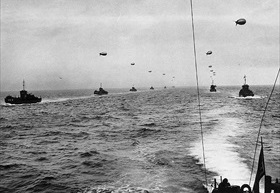 | 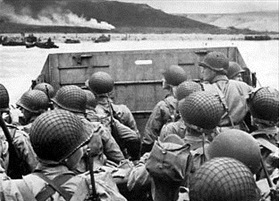 |
Left: Large landing craft convoy crosses the English Channel on June 6, 1944. The majority of troops who landed on the D‑Day beaches were from the Great Britain (112,824), the U.S. (52,889), and Canada (18,000). Close to 5,000 troops from other Allied countries participated in the D‑Day landings and the ensuing Battle of Normandy (June 6 to August 30, 1944). They were drawn from Australia, Belgium, Czechoslovakia, France, Greece, the Netherlands, New Zealand, Norway, and Poland.
![]()
Right: An American LCVP (Landing Craft, Vehicle, Personnel) approaches Omaha Beach, Normandy, France, June 6. Smoke on the shore emanates from German positions. The assault phase of Operation Overlord was known as Operation Neptune. This operation involved landing the troops on the beaches, as well as all other associated supporting operations required to establish a beachhead in France. Operation Neptune began on D‑Day and ended on June 30, 1944.
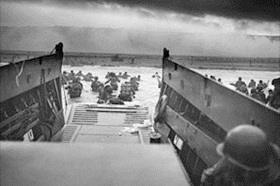 | 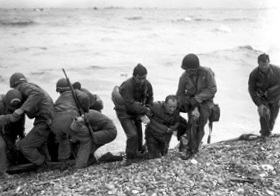 |
Left: “Into the Jaws of Death” is the description of this photo taken of Company E, 16th Infantry, U.S. 1st Infantry Division (the Big Red One) wading onto the Fox Green section of Omaha Beach at 8:30 on the morning of June 6. An earlier wave of B‑26 Martin Marauder twin-engine bombers had not even scratched the German defenses, much less created the promised instant foxholes (bomb craters), on the 3.5‑mile stretch of long, exposed beach—the 13,000 bombs dropped missed their target by 3 miles. The U.S. 1st and 29th Divisions together suffered around 2,000 casualties (two-thirds of Company E were killed or wounded) as they advanced up Omaha Beach into 4 batteries of artillery, 18 antitank guns, 6 mortar pits, 35 rocket launcher sites, 8 concrete bunkers, 35 pillboxes, and 85 machine-gun nests. A high casualty rate of officers left many low-ranking soldiers leaderless and confused on the invasion beach. Some of these soldiers were given field promotions by process of elimination. German forward units reported to headquarters that the invasion had been halted at the water’s edge.
![]()
Right: Members of an American landing party lend helping hands to others of their unit whose landing craft or DD (duplex drive) amphibious Sherman tank was sunk by enemy shore guns, high seas, or mines. Thirty-two landing craft and most DD tanks were lost this way. The survivors in this photo reached Omaha Beach by using a life raft. Most of the GIs who landed on Omaha and Utah beaches survived their encounter with death.
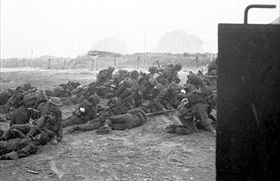 | 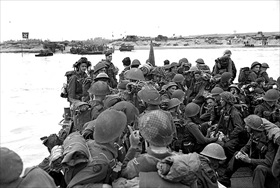 |
Left: British Second Army infantry wait to move off Queen White section, Sword Beach, while under enemy fire on the morning of June 6. By nightfall the British had 28,850 men ashore and had seized the bridge over the River Orne, a principle objective that day.
![]()
Right: Personnel of Royal Canadian Navy Beach Commando “W” land on Mike section, Juno Beach of the Normandy beachhead, June 6. Juno was the most exposed of the five invasion beaches, and the opposition awaiting the Canadians was believed greater than that facing any other Allied force. By the time they had secured Juno Beach, one in six Canadians was dead or wounded.
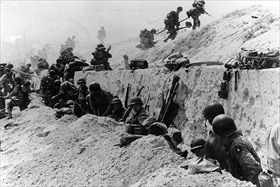 | 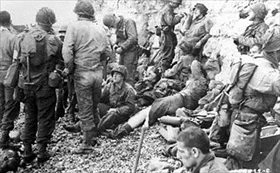 |
Left: Soldiers of the 8th Infantry Regiment, U.S. 4th Infantry Division, move out over the seawall on Utah Beach after coming ashore in front of a concrete wall near La Madeleine, France, on June 6.
![]()
Right: In a photo taken June 8 on Omaha Beach assault troops of the 3rd Battalion, 16th Infantry Regiment, U.S. 1st Infantry Division, having gained the comparative safety offered by the chalk cliff at their backs, take a breather before pushing inland.
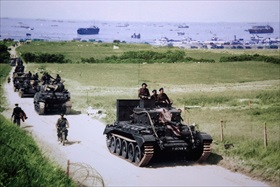 | 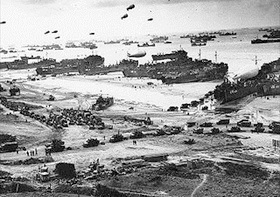 |
Left: A Cromwell tank leads a British Army column from the 4th County of London Yeomanry, 7th Armoured Division, after landing on Gold Beach on D‑Day in Ver-sur-Mer, France.
![]()
Right: Landing ships of all styles put cargo ashore at Omaha Beach at low tide during the first stages of the operation, June 1944. Indeed, toward evening on D‑Day, even the Omaha beachhead bustled with activity, having been reported safe for wheeled and tracked vehicles. Kitchens were set up and served the survivors beans and wieners and hash browns.
Operation Neptune and Overlord: The Liberation of Europe Gets Underway
![]()

 History buffs, there is good news! The Daily Chronicles of World War II is now available as an ebook for $4.99 on Amazon.com. Containing a year’s worth of dated entries from this website, the ebook brings the story of this tumultuous era to life in a compelling, authoritative, and succinct manner. Featuring inventive navigation aids, the ebook enables readers to instantly move forward or backward by month and date to different dated entries. Simple and elegant! Click
History buffs, there is good news! The Daily Chronicles of World War II is now available as an ebook for $4.99 on Amazon.com. Containing a year’s worth of dated entries from this website, the ebook brings the story of this tumultuous era to life in a compelling, authoritative, and succinct manner. Featuring inventive navigation aids, the ebook enables readers to instantly move forward or backward by month and date to different dated entries. Simple and elegant! Click 











